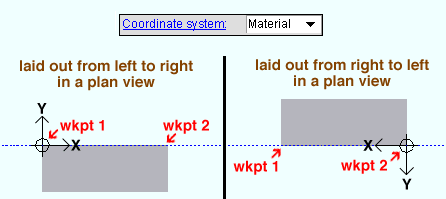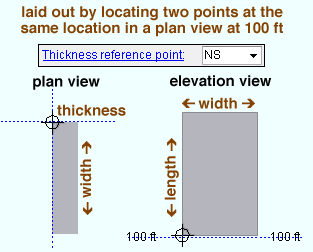 Material Add Rectangular Plate ( Modeling )
Material Add Rectangular Plate ( Modeling )
Tool summary :
Also see :
- Plate Material (topic)
- Miscellaneous members versus legacy miscellaneous members (topic)
- Rectangular plate miscellaneous member (instead of legacy)
- Rectangular Plate Material window (opens when you add rect plate as a submaterial or a legacy misc member)
- Add Material
- Show legacy miscellaneous members in member add screen (for adding a legacy misc mem using F2 )
page 1 | contents | add material | add legacy misc mem | rectangular plate window
Adding a rectangular plate material or legacy miscellaneous member :
1 . Rectangular plate can be added to the 3D model as a submaterial of a member or as a legacy miscellaneous member. In either case, locating work points should be done in a view whose work plane is orthogonal to (at right angles to) the material or legacy miscellaneous member being added. Do one (1) of the following:
|
To add a rectangular plate TO a member (pre-selection method):
To add a rectangular plate AS a legacy miscellaneous member: Confirm that the box is checked for User and Site Options > Site > "
Show legacy miscellaneous members in member add screen ." Then, in Modeling , press F2 > filter for "
Miscellaneous steel " > double-click " Miscellaneous -- Rectangular Plate " > continue to step 2.
2 . The status line prompts, " Add: ... " Locate- Pan -Return mouse bindings become active. Select the appropriate Locate option, then do either of the following:
|
|
|
bindings |
Alternative 1 : Left-click ( Locate ) at two different points to define the work line (and X material axis ) of the rectangular plate to be between those two points. The first point defines the material reference point (the pivot point around which subsequent rotation takes place). The following illustration shows the difference between laying out these points from left to right versus right to left.
Alternative 2 : Left-click ( Locate ) twice at the same location to define a cross section whose material reference point is at this location. The material's " Order length " (which must be entered in step 3) is added toward you, out of the screen. The material's work line will be perpendicular to your current view (perpendicular to the plane of the screen).
3 . After you are done laying out work points, the Rectangular Plate Material window opens. On it are settings for the rectangular plate you are adding.
3a : Enter a " Material thickness " and " Material width ." You must also enter an " Order length " if you located the two points in step 2 at the same place.
3b : Choose the " Thickness reference point " of the material and thus specify whether you want the near side, far side or center of the plate at the elevation (or relative depth) of the view in which you entered its work points (if you entered the plate by locating two work points).
3c (optional) : The " Left/right end settings " on the Rectangular Plate Material window let you specify cuts or material setbacks on the ends of the rectangular plate. The left end is the end associated with the first point you located in step 2.
3d : Press the " OK " button at the bottom of the Rectangular Plate Material window to apply your settings and exit the window.
4 . The Rotate Material window opens, and a preview of the to-be-added rectangular plate is shown on screen. Do one (1) of the following:
Alternative 1 : Press " Cancel " to back up to step 2. This stops the rectangular plate from being added.
Alternative 2 : To accept the material's present rotation, press the " OK " button.
Alternative 3 : Or you can change the material's rotational settings and then press " OK " if you want to rotate the material around various axes that originate at the first work point that you located in step 2.
5 : Different end steps are required depending on whether you are adding a material to a member or adding a stand-alone legacy miscellaneous member.
End steps for adding a material TO a member: After rotating the material into place > right-click ( Return ) if done adding material to the member > Change All Options can be applied if the member the material is being added to is batched together with other members with the same mark.
End steps for adding a material AS a legacy miscellaneous member: After rotating the legacy miscellaneous member into place > right-click ( Return ) when you are done.
Tip 1: If you added a legacy miscellaneous member (see step 1), you cannot re-open the Rectangular Plate Material window using Edit Member -- that opens the [Legacy] Miscellaneous Member Edit window. The Rectangular Plate Material window is a material window, not a member window, and you therefore have to open it by, for example, using Edit One Material , " Edit Other " on the context menu, or by double-clicking the material in the Model Tree .
Tip 2: If you added this material as a submaterial (see step 1), you can, in addition to the edit methods described in tip 1, double-click the material to re-open the Rectangular Plate Material window.
page 1 | contents | add material | add legacy misc mem | rectangular plate window | top

